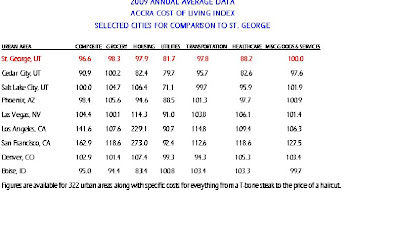
ST. GEORGE - Washington County's residential real
estate sector is showing strong signs of recovery
after posting a 41 percent surge in year-over-year
sales during the first quarter.
Bolstered by an influx of affordable bank owned-
properties coupled with attractively low interest
rates, Washington County recorded 993 sales in the
first quarter, representing an increase of 287 sales
from last year's quarterly figure, according to data
collected by Southern Utah Title Company.
With an ample selection of low-priced distressed
properties enticing buyers and driving sales
upward, Allan Carter, the manager of developer
services for Southern Utah Title Company, said
affordable pricing is a primary factor in the market's
renewed activity.
"It's being driven entirely by distressed properties,"
Carter said. "Everybody likes a good deal."
The recent sales boost likely serves as the first
indication of the market's inevitable resurgence from
the depths of the sub-prime lending crisis, said St.
George real estate agent Jeremy Larkin, of Keller
Williams Realty.
The surge in consumer activity has proven lucrative
for Larkin's business, he said, as the Realtor's sales
have doubled since the first quarter of 2009.
Larkin described the region's housing situation as
"the tale of two markets," with prospective buyers
flocking to distressed properties and other residential units boasting impressive savings
opportunities, but little activity occurring in the o
verpriced and high-end segments of the market.
"It's as though they don't exist," Larkin said of the
overpriced homes in competition with an influx of
foreclosures and other distressed properties.
Carter said it is not uncommon to see several offers
on the same foreclosure property in Washington
County, and with increased demand for housing,
prices are on the rise.
From January to March, the average price of a
dwelling in Washington County increased by about
$11,000 to $173,673. The slight increase is an
encouraging indication of recovery, Carter said.
"Every area that we measure is getting better," he
said. "We're a long way away from finding our way
back, but we are least at a point where we can
measure the improvement."
Renewed optimism in the housing sector is not
exclusive to Washington County, with Iron County
posting a similar 45 percent year-over-year sales
increase in the first quarter, said Chris Dahlin.
president of the Iron County Board of Realtors
Iron County recorded 126 sales in the first quarter,
Dahlin said, with low prices and the federal first-
time homebuyer tax credit likely motivating buyers.
Homes priced less than $200,000 account for a
majority of the region's sales, he added.
"Home prices are continuing to drop," he said.
Foreclosures and short sales remain prevalent in
Iron County, with distressed properties representing
approximately 85 percent of the county's sales in the fourth quarter of 2009.
The county's market is rife with distressed
properties, Dahlin said, and he expects the trend to
continue at its current inflated rate for another three
to six months.
"We still have a crop of foreclosures still coming on
the market," he said. "Which means prices won't be
going up."
Dahlin said he is cautious when predicting price
changes, but he acknowledged the possibility of
continued price drops in the coming months.
The future is largely uncertain for Iron County's real
estate sector, Dahlin said, as a number of factors
could suppress the positive sales trend, including
the looming conclusion of the federal first-time
homebuyer tax credit this month and the possibility
of interest rate hikes.
"There may still be pressure for prices to come
down in the near future, especially in light of losing
the tax credit availability," he said.
BY SCOTT KERBS











